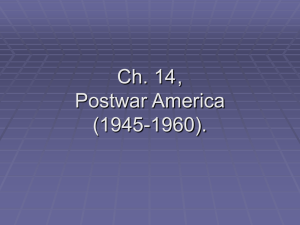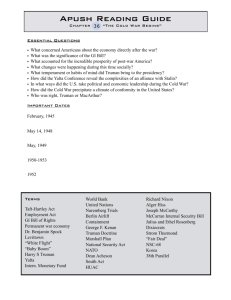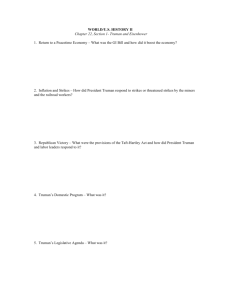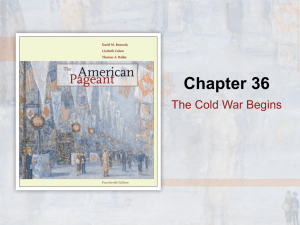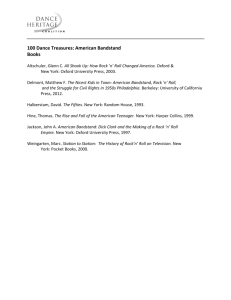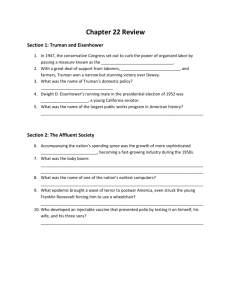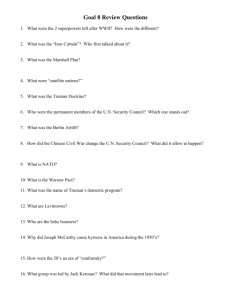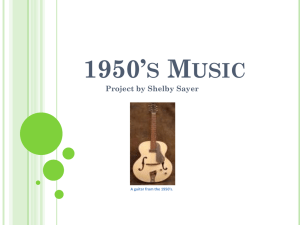Chapter 19 - Class Notes - Germantown School District
advertisement
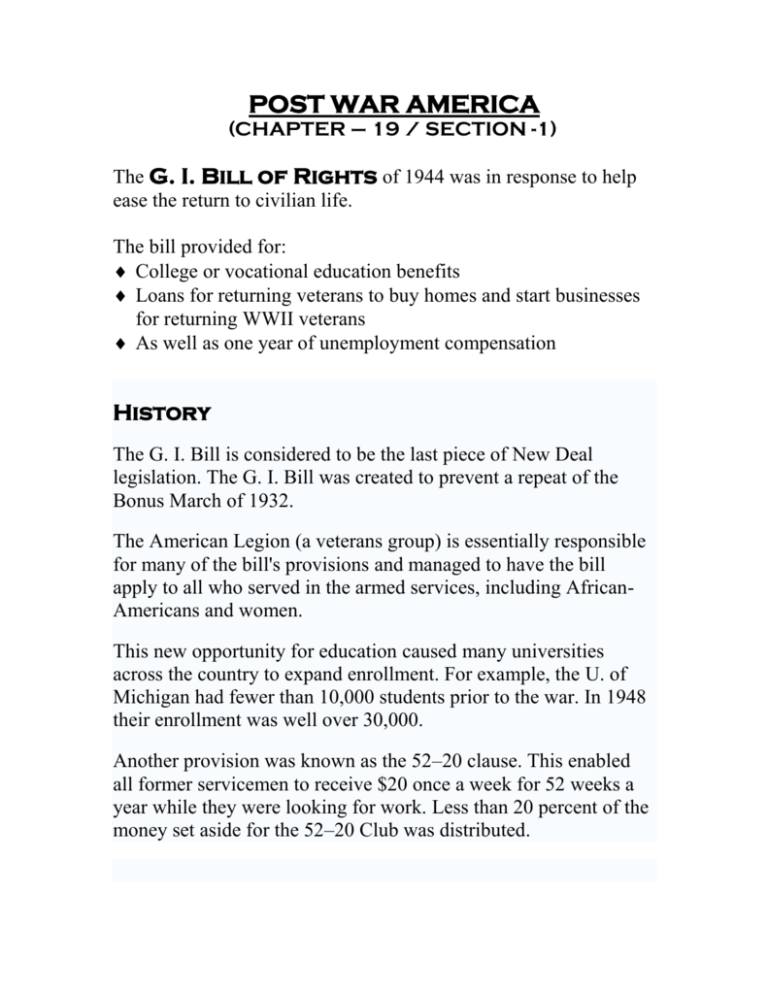
POST WAR AMERICA (CHAPTER – 19 / SECTION -1) The G. I. Bill of Rights of 1944 was in response to help ease the return to civilian life. The bill provided for: College or vocational education benefits Loans for returning veterans to buy homes and start businesses for returning WWII veterans As well as one year of unemployment compensation History The G. I. Bill is considered to be the last piece of New Deal legislation. The G. I. Bill was created to prevent a repeat of the Bonus March of 1932. The American Legion (a veterans group) is essentially responsible for many of the bill's provisions and managed to have the bill apply to all who served in the armed services, including AfricanAmericans and women. This new opportunity for education caused many universities across the country to expand enrollment. For example, the U. of Michigan had fewer than 10,000 students prior to the war. In 1948 their enrollment was well over 30,000. Another provision was known as the 52–20 clause. This enabled all former servicemen to receive $20 once a week for 52 weeks a year while they were looking for work. Less than 20 percent of the money set aside for the 52–20 Club was distributed. Housing An important provision of the G. I. Bill was low interest home loans for servicemen. A solution to the housing shortage was relieved by William Levitt and Henry Kaiser when they created housing that could be built in 16 minutes and cost under $7,000. This enabled millions of American families to move out of urban apartments and into suburban homes. Prior to the war the suburbs tended to be the homes of the wealthy and upper class. Another solution by Congress was to give financial support to clear out slums and build low-income housing units; increased funding for public housing Although black servicemen were eligible for these loans they tended to remain in the inner cities or in rural areas because many suburban communities using racial segregation did not sell homes to African Americans and other minorities. Redefining the Family Conflicts arose with the traditional make-up of the family unit. Men work and women stay at home. During the war 75% of the married women are working and at the end of the war are reluctant to give up this new found independence. By 1950 more than a million war marriages end in divorce. Economic Adjustment At the end of WWII the country goes from a footing to one of a peacetime economy. War contracts end totaling some $35 billion dollars. Many factory workers are laid off totaling some 6 million in 1946. OPA ends controls of prices on products sending costs of goods to rise some 25%, more than doubled that of products over the last three years. However, wages over that same period were less than what was made during the war. Inflation hits the people hard. Truman and Congress solution is to respond by reestablishing wartime controls on prices, wages, and rents. The Possibility of Strikes With the US worker facing higher prices and lower wages some 4.5 million disgruntle workers (steel, coal and railroad workers) went on strike in 1946. In a speech Truman will not allow the workers to cripple the nation. Truman states this solution, “he threatens to draft strikers and will order to them as soldiers to stay on the job.” Before Congress can vote on the request the unions give in. Discrimination and Racial Violence Truman bases his legacy of his presidency on the stance for improving civil rights. Truman states “if that ends up in my failure to be reelected, that failure will be in a good cause.” Truman’s solutions to this situation is by creating, Federal anti-lynching law Abolition of the poll tax as a voting requirement Establishment of a permanent body to prevent racial discrimination in hiring Passage of federal legislation to eliminate discrimination in voting Integration of the armed forces Supreme Court rules that lower courts could not bar African Americans from residential neighborhoods. The 1948 Election With the Republicans gaining control of Congress the Democrats believed that they could not win the white house with Truman. However, Truman wins his parties nomination to run for President. A splinter group of Democrats that did not like Truman’s handling of the labor strikes created a new Progressive Party and nominated Henry Wallace. Southern Democrats who opposed Truman’s actions on civil rights joined the States' Rights Democratic Party, often known as a Dixiecrat. The 1948 splinter from the party: for over a century, white southerners had overwhelmingly been Democrats, but that year many bolted the party and supported Strom Thurmond’s thirdparty candidacy for president. This group opposed racial integration and wanted to retain Jim Crow laws. The party slogan was "Segregation Forever!" The walkout of the Dixiecrats was prompted by a controversial speech by then-Mayor Hubert Humphrey of Minneapolis, MN urging the party to adopt an anti-segregationist plank in the platform, which it did. Even before the convention started, the Southern delegates were upset by President Truman’s executive order to racially integrate the armed forces. The split in the Democratic Party in the 1948 election was seen as guaranteeing a landside victory by the Republican nominee, Thomas E. Dewey. Right up to the night of the election public opinion polls predicted a landside victory for Dewey. Yet Truman won re-election in an upset. Truman’s successful reelection was based upon: His veto of the Taft-Hartley Act won back labor support Many of the Progressive party voters switched back to Truman when it looked as if Dewey may win American economy was recovering due to the Cold War spending and the ability to shift back to prewar production Personal income increased African American supported the anti-segregation platform Fair Deal With reelection in hand Truman felt that Americans would support a series of reform programs known as the Fair Deal. President Truman’s policy of social improvement was outlined in his 1949 State of the Union Address. The name of the policy came directly from this address, in which Truman stated that "Every segment of our population, and every individual, has a right to expect from his government a fair deal”. The range and breadth of Truman's "Fair Deal" proposals were: Provide full employment, Higher minimum wage, A national health insurance plan, More affordable housing, Increasing Social Security benefits, Unemployment relief Aid for farmers. I Like Ike Republicans use the following to raise doubt within the US people Rise in Communism around the world (examples?) Growth of federal government, alleged bribery & corruption “Checkers speech” regarding Nixon taking gifts from supporters Eisenhower creates “Dynamic Conservative” when it comes to government economics and liberal when it comes to people Brown v. Board of Education Supreme Court case that required that public schools must be integrated Brown v. Board of Education Many states, in both the North and South maintained separate schools for black and white students. Most ran schools as such on the doctrine of "separate but equal". In 1950, from the Sweatt v. Painter case the Supreme Court went farther to clarify that African Americans must be provided with the same level of instructors, facilities and academic prestige. Starting in 1950 the NAACP put their efforts into abolishing segregation in public schools. Thurgood Marshall led the courtroom battle for the NAACP on the Brown v. Board of Education of Topeka. This case was a landmark decision of the U.S. Supreme Court which explicitly ruled that segregation in public schools was illegal. Brown did not, however, result in the immediate desegregation of America's public schools, nor did it mandate desegregation of public accommodations, such as restaurants or bathrooms, that were owned by private parties, which would not be accomplished until 1964. Social implications Not everyone accepted the Brown v. Board of Education decision. In Virginia, Senator Byrd (D) organized a resistance movement that included the closing of schools rather than desegregating them. Rosa Parks The African Americans pay their fee in front and then reenter in the back of the bus where they would ride. If the front filled up; then blacks were asked to give up their seats in the back. Parks was a seamstress by profession, educated and was the secretary for the Montgomery chapter of the NAACP. Her arrest was a test case which allowed them to challenge segregation on public buses. She was arrested on Thursday, December 1955 for refusing to give up her bus seat to a white passenger. She was found guilty and fined $10 plus a court cost of $4, but she appealed. Rosa Parks is now considered one of the pioneering women of the civil rights movement. Eisenhower was not a leader in the civil rights issues but did press hard for programs that would bring A balance budget and a cut in taxes Extension of Social Security benefits Raise in the minimum wage Increased funding for public housing Creation of the Interstate Highway system Department of Health, Education and Welfare THE AMREICAN DREAM IN THE FIFTIES (CHAPTER – 19 / SECTION -2) By 1956 most of America had gone from blue-collar jobs to higher paying white-collar jobs. (What is the difference in these types of jobs?) The 1950’s brought on new business trends in corporations. Examples were conglomerates (a major corporation that holds a number of smaller unrelated companies) and in franchises (a company that offers similar products or services in many locations). The effects that this had on American society were: Standardized what people ate Offered economic advancement to people who would conform Offered job security to more Americans Contributed to the baby boom and suburbanization Offered consumers more choices In general the business world no longer wanted creative thinkers, rebels or anyone who would rock the corporate boat. Several changes were emerging in the work place. Automation increased in many factories during the 1950’s resulting in the loss of many industrial workers jobs. This was the use of machines within the process of manufacturing products. Unions were most often affected by the use of machines. The unions were being investigated for misuse of funds and a report that unions might be supporting socialism or communism. These allegations began to reduce the power of unions. Another technological advancement was in jet planes. The development of commercial jet planes helped in long-distance travel being less expensive and could carry more passengers. The Suburban Lifestyle With the development of a highway system, affordable cars and cheap gasoline people moved from the city to the suburbs. People were given the chance to live the American dream. Good homes, good schools, a safe and healthy environment for children and good neighbors. This movement created many effects on Americans, especially women, to feel dissatisfied with their lives. It also led to the decline of cities creating racial and economic gulfs between suburban and city dwellers. The Baby Boom Once the returning soldiers from the war settled into their lives an unprecedented population explosion occurred. The effect was created the largest generation in U.S. history contributing to suburbanization and business expansion. It also led to widespread overcrowding in schools and a teacher shortage. Communities began to create a boom of activities geared toward the needs of the youth. Dr. Jonas Salk Medical advances would be made that would save thousands of lives and prevent childhood diseases such as typhoid fever. However, one of the breakthrough discoveries came when a vaccine for polio was created by Dr. Jonas Salk. Women’s roles in America As the 1950’s came to a close the roles of women or the desire to expand began to go against the norm. Stay at home mothers that maintain the suburban dream. However, the Carol Freeman began to expose the discontent that existed within the feeling of women. Women are bored, not happy with their roles, feel isolated, and unfulfilled. Betty Friedan writes in her book the “The Feminine Mystique” that each generation has exposed a crisis in where women are growing up. (What opportunities will become available to women?) Career opportunities lie in nursing, teaching and office secretaries Women earn less than men in comparable professions Women attend college in greater numbers yet receive little financial, academic and psychological support to pursue any goals Leisure in the Fifties The 1950’s offered a major increase in leisure time due to 40 hour work weeks and multiple weeks of vacation per year. The effect of this growing free time causes growing demands upon business to expand its type and variety of leisure activities. Americans spend some 30 billion in leisure goods and activities. This also gave people time to engage in a wide variety of recreational pursuits in active and passive activities. (Examples) The Automobile Culture The cheap supply of gas, costing fewer than 10 cents a gallon and the easy credit terms to buying a car led to a rise in cars under private ownership. The effects of this rise led to: The building of roads and interstate highways Encouraged suburbanization and urban decline Helped the trucking industry to take business from the railroads Helped to unify and homogenize the nation Offered Americans more possibilities for leisure activities Stimulated other industries, created noise and air pollution and led to more traffic jams and accidents The Highway Act of 1956 appropriated $25 billion for the construction of more than 40,000 miles of interstate highways over a 10-year period. The Act is said to have been developed by the drawing of six lines (three vertical and three horizontal) on a piece of paper. Eisenhower told his people to base their freeway system on it. Support of the Federal-Aid Highway Act of 1956 can be directly attributed to a Lt. Col. Dwight David Eisenhower experience in 1919 when the U.S. Army had its first Transcontinental Motor Convoy cross the United States. That experience, plus his observations of the German autobahn network during WWII, convinced him to support construction of the Interstate System. Eisenhower argued for the highways for the purpose of national defense. In the event of an invasion by a foreign power, the military would need good roads to be able to quickly transport troops around the country. Consumerism Unbound By mid-1950 nearly 60% of America was middle class, nearly twice as much prior to WWII. With money and newly created products people searched for products that would give them prestige and free time. The effects that Consumerism had were: Helped to popularize the equating of material goods with success Contributed to the expansion of business through media outlets Encouraged manufacturers to produce a wider variety of goods to meet the changing tastes or habits of people Encouraged planned obsolescence and the “throwaway society” Caused an increase in private debt and led to a boom in the advertising industry The cost of a television commercial in the 1940’s for a one-minute commercial was $9. In 1960 advertisers spent nearly 1.6 billion for television ads. In a 2001 super bowl 30 second ad an advertiser will spend 2.2 million. (What does television symbolize today?) POPULAR CULTURE IN AMERICA (CHAPTER – 19 / SECTION -3) The Golden Age of Television In 1946 there were fewer than 10,000 television sets in the U.S. In 1948 only 9% of the US homes have TV’s. By 1960 almost 90%, some 45 million households have television sets. Milton Berle, an early vaudeville star, turned to T.V. headlining the Texaco Star Theatre. His ever lasting appearances on T.V. earned him the nickname of “Mr. Television”. Another very popular TV show was I Love Lucy starring Lucille Ball. She would take on any challenge and did many physical stunts on television. The Federal Communication Commission (FCC) regulated and licenses television, radio and other communication industries. Other television subjects presented were comedy, westerns, game shows, soap operas and dramas. Each of the shows had an individual sponsor. T.V. success led to more and more commercials, by 1950 advertisers were spending more than 175 million per year and in 1960 it was 2 billion to influence American consumers. An idealized white America is what was shown. Television stereotyped the portrayal of women and minorities. Men appeared on shows 3 times more than females. Females were house wives, secretaries, teachers and nurses. Minorities were rarely seen on TV but were resigned to cooks, house servants, ground keepers and usually the poor, bad element of society. Radio and Movies As much as TV became popular, radio and the movies still held their ground. Some of the radio changes were reporting local programming and the targeting specialized audiences. In African-American culture hundreds of stations focused on African-American performers, helping to sell their records. Movie films made changes by introducing innovations such as stereoscopic sound and Cinema-Scope to capitalize on its advantages over TV. It also introduced such fads as piped-in smells and 3-D movies. Young people would attempt to identify with actors that were rebels. James Dean, who only made three movies due to a car accident at the age of 24, and Marlon Brando portrayed young rebels in popular movies. A Subculture Emerges Young writers of the time were known as “beats or beatniks". Since 1958, the term beatnik has been used to describe an antimaterialistic literary movement that began in 1948, stretching on into the 1960s. Some of the early beatnik writer’s, Ginsberg and Kerouac, philosophy was filled with non-conformity, anti-materialism, interest in a higher consciousness and the shunning of structure in life. This style of writing influenced some of the lyrics of popular 1960 musical groups such as the early Pink Floyd and the Beatles, and was a precursor of the hippie generation. The Beatniks were stereotyped as men wearing goatees and berets and playing the bongos. Fashions for women included black leotards and wearing their hair long, straight, and unadorned. This was a rebellion against the middle-class standards of the time which expected women to get perms for their hair. Participants in this subculture often preferred to drink wine, coffee, or tea rather than more mainstream beverages such as beer or hard liquor. Marijuana use was also associated with the beatnik subculture. African Americans and Rock n Roll During the 1950’s African American writers, Ralph Ellison and James Baldwin were social critics. Ellison’s “Invisible Man” wrote of a man’s search for identity in the post war world. Baldwin wrote of the racism in his book “Notes of a Native Son”. Even though these writers attacked U.S. social problems they strongly supported America. Different styles of music began to appear in the 1950’s. One was Bebop and the other Rock n Roll. Bebop Is a complex mix of jazz, with a rapid pace that differed drastically from the straightforward compositions of the swing era. It was instead characterized by fast tempos, complex harmonies, intricate melodies, and rhythm sections that expanded on their role as tempo-keepers. Rock n Roll Is a defined genre of music that originated in the Southern U.S. in the 1950’s from the rhythm and blues to Rock n Roll. It later evolved into the various sub-genres of what is now called simply 'rock'. From the late 1950’s to the mid 1990’s rock was one of the most popular forms of music in the western world. Rock and roll is most typically played with an electric guitar, an electric bass guitar, a drum kit, and sometimes a piano or keyboard. In the early rock and roll style of the early 1950s, the saxophone was often the lead instrument, replaced by guitar in the late 50's. Elvis Presley was the biggest rock star of the 50’s. His voice, charm looks and style of dancing helped him sell millions of records, starred in over 30 movies and was a main stay in Las Vegas. Early North American rock and roll (1953-1963) Whatever the beginning, it is clear that rock and roll appeared at a time when racial tensions in the United States were coming to the surface. African Americans were protesting segregation of schools and public facilities. It can hardly be a coincidence, then, that a musical form combining elements of white and black music should arise, and that this music should provoke strong reactions, of all types, in all Americans. In March of 1952, in Cleveland, Alan Freed (also known as Moondog) organized the first rock and roll concert. The audience and the rock n roll musical performers were black and white. The concert ended after one song in a near-riot as thousands of fans tried to get into the sold-out venue. The record industry soon understood that there was a white market for black music that was beyond the social prejudice and racial barriers could do nothing against market forces. Rock and roll was an overnight success in the U.S. making ripples across the Atlantic, culminating in 1964 with the British Invasion. Social Impact The massive popularity and worldwide scope of rock and roll resulted in an unprecedented level of social impact. Far beyond simply a musical style, rock and roll influenced lifestyles, fashion, attitudes, and language in a way few other social developments have equaled. The Racial Gap African Americans had inspired the birth of Rock n Roll. But throughout the 1950’s African American shows were broadcast on separate stations. These stations targeted specific groups and with specific marketing targets. Minority groups were not able to have their own TV sets and turned to radio as a source of entertainment and source for news. Segregation in this media and music outlet led to further strained relationships within America. This practice would lead to a violent and uneasy time within the 1960’s. THE OTHER AMERICA (CHAPTER – 19 / SECTION -4) The 1950’s was regarded within US history as a time for prosperity and great development. However, not everyone shared in this growth. One out every four Americans is living below the poverty level. Many of these people are elderly, single women and their children and minority groups. White Flight One of the causes for the plight of the cities was the “White flight”. Millions of Americans left the cities for the suburbs taking with them the needed economic resources and the beginning of isolation from other races and classes. In turn the rural poor move to the inner city. The switch created a void in tax money that supported city improvements in schools, transportation or in police and fire services. Urban Renewal With the Middle-class moving to the suburbs and leaving behind many poor people with fewer tax dollars, a city began to fall into decline. A solution offered by the federal government in attempt to fight the decay of major cities was the Urban Renewal program. The effects are a large section of downtown at the heart of the city was demolished, converted to parks, office buildings, and a sports arena. Cleared areas are not always used for housing, which led to housing shortages for minority groups. Long-term implications While urban renewal never lived up to the hopes of its original proponents, it has played an undeniably important role in cities throughout the United States. It has brought economic and cultural development to many cities, but often at a great cost to low-income and minority communities living in them. It has also played a role in the economic devastation faced by many of the major industrial cities in the United States. Poverty Leads to Activism During each of the World Wars the US has relied upon and gotten the help form the Mexican migrants that crossed into this country looking for work. During WWII Braceros or hired hands were allowed into the US to harvest crops. Once the war was over they were expected to leave and to return to Mexico. However, many of them stayed. Many more would come to flee the economically torn Mexico. Incidents of discrimination have prompted Mexicans to form voting groups that would choose candidates that support their needs and rights as people. Native Americans continue their struggle Through the course of time the Native Americans have maintained their fight to become equal citizens. Causes for problems with the Native Americans came as WWII ended and they would soon find out that the government would stop paying allotments and wages. The solutions was the creation of the American G.I. Forum, the Unity League of California, and voter registration groups in other states Native Americans to battle against the governments injustices. Another cause for problems was the termination policy adopted by the federal government. The US government would eliminate federal economic support and discontinue the reservation system. The solutions was the Bureau of Indian Affairs began a voluntary relocation program to help Native Americans find a place to live and work and to pay for moving and living expenses. The overall effects was only 35,000 Native Americans relocated in the program, with many of them unable to find jobs and the number of Native Americans on state welfare rolls soared. In 1963 the Termination Program was abandoned.
